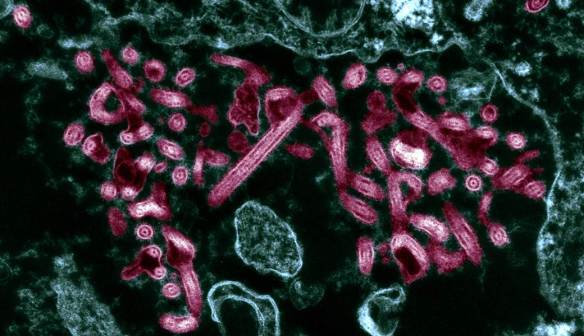
http://www.nbcnews.com – A Transmission Electron Micrograph (TEM) of the Ebola virus RNA
Ebola is a clearly under-studied disease as no vaccine or treatment exists. We, at IEDB, in turn, were also surprised to see how little data on Ebola epitopes were reported to date. It took us just a couple of days to report on available data and a bit longer to get an attention (well, I am not good at publicity as I write this in a month since we published the first report, while Ebola is not getting away, and we are working on a larger publication).
To summarize, the EBOV genome encodes seven proteins: envelope glycoprotein (GP), nucleoprotein (NP), polymerase cofactor (VP35), transcription activator (VP30), matrix protein (VP40), secondary matrix protein (VP24), and RNA polymerase (L). There were reported 44 T cell and 15 B cell epitopes for GP (the surface protein and the most important target for antibodies) and 10 T cell and 20 B cell epitopes for NP, with a far fewer epitopes reported for other proteins. Unexpectedly, human and non-human primate hosts were absent in the T and B-cell assays, with murine hosts predominated and a smaller number of rabbit studies reported only for antibodies.
What was also surprising to us that of the monoclonal antibodies (mAbs) described to date, only one was derived from a human survivor of Ebola disease of the 1995 Kikwit outbreak (mAb KZ52). Only nine mAbs showed to be protective in mice (just recently, a new study using macaque was published in Nature) or in in vitro virus neutralization assays. Six of these mAbs comprise the three cocktails, ZMab, ZMapp, and MB-003, that have being evaluated as treatment options for Ebola disease, and ZMapp was presumably contributed to the successful treatment of two patients in the US. There were reported efforts to increase the Zmapp production after the already mentioned publication in Nature (as FDA clears an Ebola therapeutic approval for human if it was successfully tested in macaque).
It should be expected that the current attention to Ebola will result in discovering new protective human antibodies and immunodominant epitopes from survivors of the current outbreak, which can be used as therapeutics.
[When I was about to click submit, my husband asked me what this my post had to do with BigBioData. So I capitalized “Little” in the title — sometimes we wish to have Big Data, but we don’t realize that acquiring them might cost lives as it was with collecting and sequencing Ebola strains in current outbreak.]